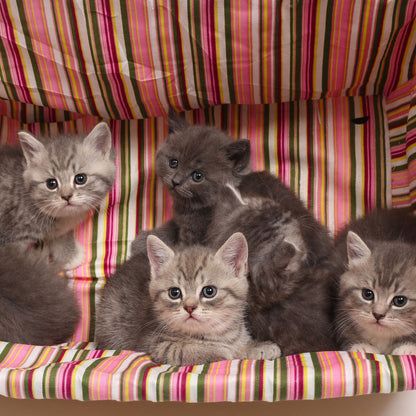
Cats are often perceived as solitary creatures, but the reality is that they can form deep and complex social bonds, particularly within their families. Understanding these relationships can deepen our appreciation for our feline friends and their unique behaviors.
The Structure of Cat Families
In the wild, cats often live in colonies where they form close-knit groups. These colonies typically consist of related females and their offspring, while males tend to be more transient. Domestic cats, even though they might not live in such colonies, still exhibit strong familial bonds.

1. The Mother-Child Bond: The bond between a mother cat (queen) and her kittens is profound. From birth, the queen is highly attentive to her kittens, providing warmth, grooming, and teaching them essential survival skills. This period is crucial as it shapes the kittens’ future behavior and social skills.
2. Sibling Relationships: Kittens that grow up together often develop strong bonds. They engage in play that helps them learn important social cues and behaviors. These sibling relationships can remain strong into adulthood, especially if the cats are not separated.
3. The Role of Fathers: In domestic settings, father cats (toms) are usually not involved in the upbringing of the kittens. However, in some cat colonies, toms can take on protective roles, especially towards the kittens.
Social Behaviors in Cat Families

Cats communicate and strengthen their bonds through various behaviors:
1. Grooming: Mutual grooming, or allogrooming, is a common behavior among cats that strengthens social bonds. It’s a way for cats to show affection and reinforce their social structure.
2. Play: Play is vital for kittens as it helps them develop hunting skills and social interactions. Even adult cats engage in play, which can be a sign of a healthy and strong bond between them.
3. Sleeping Together: Cats that are comfortable and trust each other often sleep in close proximity or even cuddle together. This behavior is a clear indicator of a strong familial bond.
The Impact of Separation
Separation from family members can have a significant impact on cats. Kittens that are separated from their mother and siblings too early may develop behavioral issues and struggle with social interactions. Ensuring that kittens stay with their family for an adequate period is essential for their development.
Integrating New Cats into a Family

Introducing a new cat into a household with existing cats requires patience and careful planning. It’s important to:
- Give Time for Adjustment: Allow the new cat and the existing cats time to adjust to each other’s scent and presence.
- Gradual Introduction: Introduce them gradually, starting with short, supervised interactions and gradually increasing the time they spend together.
- Provide Separate Resources: Ensure that each cat has its own resources, such as food bowls, litter boxes, and resting spots, to reduce competition and stress.
Conclusion
Cat families are fascinating and intricate. By understanding and respecting their social structures and bonds, we can create a more harmonious environment for our feline companions. Whether in the wild or in our homes, the family bonds among cats play a crucial role in their development and well-being. So next time you see your cats grooming each other or cuddling up together, remember that you are witnessing a beautiful aspect of their social nature.

